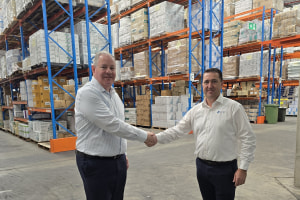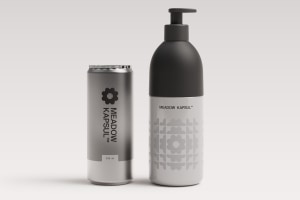Pepe Saya’s co-founder and chief buttermaker Pierre Issa started the premium butter business in 2010, with a rudimentary business plan to “make good Australian butter”. Today it stands as best in class, not only for flavour, but for the processes used and commitment to premium local ingredients. The batch churned cultured butter is now about to be produced outside of Australia for the first time.
Before Pepe Saya, Issa had a business making grab and go desserts for Thomas Dux and Harris Farms. Then, one Christmas, they had 200 litres of cream left over that they didn’t want to go to waste, so he thought he’d try making butter.
“It was dreadful, but over that Christmas I started researching and found a niche – it turned out that restaurants in Australia were buying butter from overseas for the whole year. They’re reasoning for not using Australian butter was that it tasted like salt and water.
“If someone flies to Australia and goes to a restaurant, they should be eating Australian butter,” Issa said.
He says that the timing was right for Pepe Saya and other companies followed soon after.
“We might have been the first to do it, but others were also thinking about it.”
Since launching Pepe Saya, its Caringbah creamery has been upgraded but stays true to its ‘slower food’ roots.
The retail sized butters and two-kilogram wheels are still hand packed. The single serve portions are made using a machine from Switzerland.
“It was used to produce Laughing Cow cheese. We had it shipped to France where it was retooled to make a round instead of a triangle. It is semi-automated but requires three hours of maintenance a day, with adjustments every time you use it,” Issa said.
The buttermilk is made in a 1960s Seal-o-Matic from the US and the fermenting tanks are repurposed 1952 Truscott farm tanks. In them, the company ferments cream into crème fraiche.
The production method uses the same principles as making yoghurt but instead of milk uses cream and a different strain of bacteria – lactobacillis – which is high in lactic acid bacteria.
The butter is made in a batch churn, as opposed to a continuous churn.
“You can’t make cultured butter in a continuous churn because it’s the fermented cream needs to be at a certain temperature and consistency, which is too thick,” Issa explained.
From 1000 litres of crème fraiche – as large as the batch can be – 500 kilograms of butter is produced. Pepe Saya produces 10-12 tonnes of butter a week, up to 24 batch churns a week.
The culture is added after it is pasteurised, meaning it is alive in the butter and making its flavour profile change over time.
“The butter almost has a bell curve flavour profile – creamy and sour when it is first made, then becoming harder and less creamy as it ages. At the top of the bell curve at six weeks, it has floral notes and is more solid, and as you come down the curve it is more pungent and cheese-like. It is like old school butter.
“It is a slower food, which means it is made completely differently. It’s more porous with a texture and flavour unlike standard butter, which can live on the bench for a week or survive at the back of the fridge. That is a functional product. If you want a beautiful product that talks to you, that’s our butter,” he said.
Beyond the borders
In 2019, the company go its export licence. Because of its niche market, Issa knew they could only sell a certain amount of butter at a particular price point based on the size of the market. The team also had an export philosophy.
“Where there are no cows, we export our butter. Where there are cows, we export the brand. That has been a deep philosophy for us since day one,” he said.
The first export markets were South-East Asia and Saudi Arabia – places with no cows. “When you realise there is no difference in cost shipping a box to Singapore than there is to Perth, you start thinking differently,” Issa said.
Then the company looked to the US. During the pandemic, grocery company Central Markets in Texas approached Issa as a distributer, because the US government was subsidising freight.
“It was an experiment for us, we looked at the data and saw potential, so Melissa (co-founder and Issa’s wife) and communications manager Georgia Somerville went to the Fancy Food Show in the US looking for dairy partners and distributors.

“That’s how we met the Amish,” he said.
Pennsylvania had given the Amish a stand at the expo. Brother Daniel visited the Pepe Saya stand and spoke to Melissa, who on her return to Australia told Issa, “You have to talk to him, he’s your people”.
That phone call, meant for 10 minutes, lasted more than two hours.
“I said, we’re handshake people, so you’ll have to come here to see how we make it, and I’ll have to come there to see if we like each other, and then buy the equipment. It’s been a wild ride,” Issa said.
For the Amish community in Lancaster, Pennsylvania, dairy farming has been central to its commitment to producing premium quality, hand crafted produce using traditional practices for more than 300 years. Their cream comes from grass-fed cows an regenerative family run farms using no pesticides.
There are around 5000 cows in Lancaster County, with an Amish family owning between 100-200 cows.
“The Amish want a better price for their milk – at the moment if they sell it to the tanker they get 27 cents a litre, if they sell it at farmgate, they get $5. They also want more and better jobs for the community.
“We need skilled labour that understands handmade, with good management skills, and a food grade production site, it just clicked.
“My time in Lancaster County was filled with exchanges of culture. I felt like I had taken a step back in time to see how things were done before the birth of the machines that rule our lives in today’s fast paced world. I was absolutely blown away by the Amish hospitality and their dedication to their unique and best in class farming practices,” Issa said.

Brother Daniel of Brother Daniel’s Amish Farms said, “We are delighted to bring Pepe Saya’s incredible Australian cultured butter directly to the US market. Our circular farms produce Grade A Dairy, we’re all natural and non-GMO and our happy cows produce the highest quality cream.”
Pepe Saya will be providing the equipment and IP for production.
“The master butter maker has been making butter since he was a kid. We’ve taught them the skills of making a cultured butter – it’s softer, holds more water – and how to package it.
“We want to use a master distributor and will have product out of Australia for that market until we’re all set up and have tested the market,” Issa said.
Issa also went to existing stakeholders in the US for their blessing. “We want to get it right. We see this as a partnership with the Amish and for the long term. It’s the same process as setting up in Australia. When it starts to grow you reinvest into the business with more equipment,” he said.
Issa said they will initially product to demand, expecting to work up to five tonnes in the first six months and then ramp it up year on year.
“We crawl, walk, then run. We don’t want to take over America, we want people to find us organically and see how it goes.
“It’s driven by the will to do something with purpose and integrity – our drive is to see where this brand can go and where can we take it,” he said.







